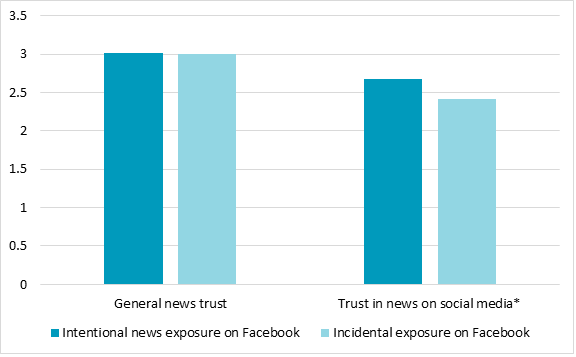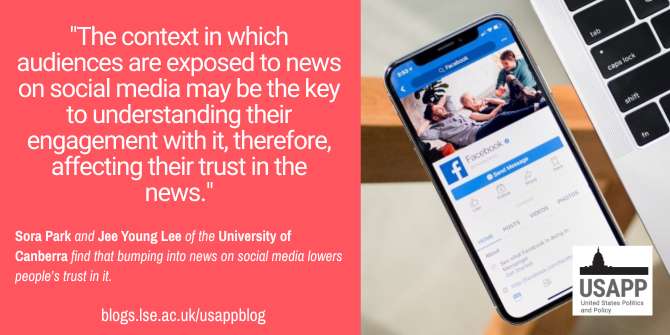
 Social media has become an incredibly important source of news information, globally. But how does how people encounter news on social media affect their trust in it? In new research, Sora Park and Jee Young Lee analyzed survey responses from Australia, the UK and the US find that the context of people’s Facebook news consumption is important: finding news on Facebook by accident is linked to people trusting news found on social media – though not news as a whole – less. Self-curation of news on social media, they write, may be one way for social media users to maintain trust in what they read.
Social media has become an incredibly important source of news information, globally. But how does how people encounter news on social media affect their trust in it? In new research, Sora Park and Jee Young Lee analyzed survey responses from Australia, the UK and the US find that the context of people’s Facebook news consumption is important: finding news on Facebook by accident is linked to people trusting news found on social media – though not news as a whole – less. Self-curation of news on social media, they write, may be one way for social media users to maintain trust in what they read.
Social media has become an important source of news among global citizens; one-third of the global population use Facebook as a source of news. In new research, we explored how people encounter news on social media and what it is doing to their trust in news.
Using online survey data that was collected as part of Reuters Institute Digital News Report 2021, we analyzed nearly 1,300 respondents who regularly use Facebook for news in Australia, the UK and the US.
The data show that about half the time news consumption on Facebook is incidental; 46 percent of Facebook users in Australia, 56 percent in the UK and 47 percent in the US bump into news while doing other things (see Figure 1). Many people are exposed to news without actively seeking it out. This may be a positive thing as people can be more informed. However, some suggest that only those who are interested in news engage with it anyway, which can widen the information gap.
Figure 1 – Incidental vs intentional news consumption on Facebook

Social media means more incidental exposure to news
Incidental exposure to news is not a new phenomenon. Newspaper headlines that readers see on newsstands, or news clips that appear when changing through TV channels have always been a part of everyday news consumption. However, it has become a topic of growing interest in recent years because people tend to use social media and online platforms sporadically throughout the day and incidental exposure to news has become more prevalent.
Digital platforms such as search engines, social media and mobile apps have opened new opportunities for news audiences to access a diverse range of information online. However, this has also resulted in the growing uncertainty about the reliability and facticity of online information and an increase in mistrust. There is a global concern about the decline in trust in public institutions including the media.
In our study, we explored whether the method of encountering news on social media could be related to audiences’ trust in the information they see. Our analysis shows that incidental exposure to news on Facebook has a negative relationship with trust in news found on it. Individuals who come across news stories incidentally are less likely to trust the information they encounter, compared to those who seek out news intentionally. On the other hand, incidental exposure to news on Facebook does not have a significant impact on audiences’ general trust in news. Incidental exposure to news only affects trust in news found on social media (see Figure 2).
Figure 2 – Trust in news by method of news consumption

Note: The level of trust was measured on a five-point Likert type scale.
*mean difference significant at p<0.05
Trust in the news in general vs. trust in news from social media
Generally, people trust news in general more than they trust news found on social media. However, the picture is more complex when we examine trust among social media news consumers – those who mainly get news from social media.
Those who actively seek news on Facebook have similar levels of trust in news in general and news found on social media. They are generally mistrusting of all news, regardless of where they see it. This audience are those who are those actively seeking news on social media by following and curating. And they expect to see news when they open their social media apps.

Photo by Timothy Hales Bennett on Unsplash
In contrast, as Figure 3 shows, there is a considerable trust gap between the trust placed in general news and news found on social media, among social media news consumers who bump into news. Those who don’t curate news on their Facebook feeds and encounter news incidentally, are much less likely to trust the information. These people say they rely primarily on social media to get news, but it is mostly incidental, and they don’t trust it. Instead, they say they trust other sources of news.
Figure 3 – Trust in news by main source of news
Self-curation of news can enhance trust
On social media people have little control over the content they see. In this environment passive learning occurs when users have fewer barriers to absorbing information, indicating the importance of engagement. Those who are expecting to see news on social media are more likely to engage with the content when they bump into it. Whereas those who are not actively curating news on social media may feel off guard when they see news. The context in which audiences are exposed to news on social media may be the key to understanding their engagement with it, therefore, affecting their trust in the news.
Self-curation of news on social media by following trustworthy sources is one way to manage the overwhelming volume of information available on the internet. These audiences are getting trustworthy news by utilizing the resources and tools available on social media.
News exposure on social media must be understood in the context of a wider range of activities. In such an environment where news is mixed with other information, including personal and social posts, most people are selective and vigilant about the credibility of the information they see, some are exercising yet another step of curation and personalization.
- This article is based on the paper, ‘Incidental News Exposure on Facebook and Its Relation to Trust in News’ in Social Media + Society.
- Please read our comments policy before commenting.
- Note: This article gives the views of the author, and not the position of USAPP – American Politics and Policy, nor the London School of Economics.
- Shortened URL for this post: https://bit.ly/3zzlYBe






